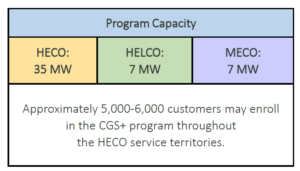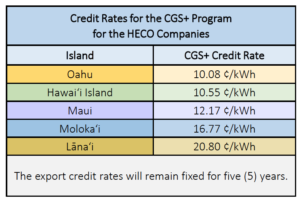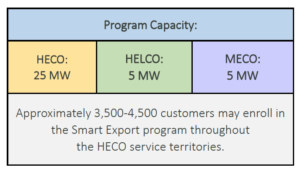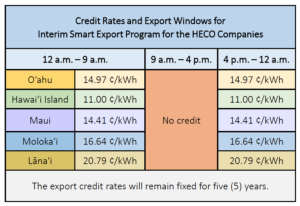The Hawaii Public Utilities Commission (HPUC) recently approved two new Hawaii solar programs that will expand opportunities for customers to install rooftop solar and battery energy storage systems for 2018. Bear in mind that the new programs are under review and won’t be finalized for 60 days, but they are called, ‘Controllable Customer Grid Supply’ CGS+ (no solar battery required) and Smart Export (solar battery required).
The utility and regulators have promised that customers will be able to switch from either ‘Customer Grid Supply’ (CGS) or ‘Customer Self Supply’ (CSS) to any of the future programs. The most important thing is to reserve your grid space today, don’t wait!
Want solar on your home?
We can prepare a free estimate to put solar on your home including purchase options and energy savings for the next 20 years. Every solar project starts with a quick conversation to discuss your energy use and roof type.
How can I get to the top of the queue for ‘Controllable Customer Grid Supply’ CGS+ and Smart Export?
Hawaii home owners will be competing with large commercial and industrial customers for approval to install rooftop solar systems, and we expect grid space to be used up quickly.
Most importantly, for anyone thinking about going solar or midway through a proposal just remember it is first come, first serve.
Don’t wait for the Hawaii Public Utility Commission (HPUC) and Hawaiian Electric to finalize the programs.
Apply now with Rising Sun Solar and we will switch you to the program of your preference ‘Controlled Customer Grid Supply (CGS+) or ‘Smart Export’.
Should you wait for more information first?
The short answer to this question is, no. If you have any interest in going solar now or in the future, the best thing to do today is apply now for ‘Customer Self Supply’ (CSS) and then switch to the program of your preference, CGS+ or Smart Export once they are finalized. The new home solar programs are not scheduled to be released until 2018, and will have limited availability.
About ‘Controllable Customer Grid Supply’ CGS+
‘Controllable Customer Grid Supply’ CGS+ is a the new version of the popular ‘Customer Grid Supply’ (CGS) program. In summary:
- No solar battery required.
- Home solar photovoltaic system required.
- Export excess energy: Will export any of your home solar panel’s excess energy to the grid during the daytime.
- You will receive a credit on your monthly bill for electricity sent to the grid.
- Annual settlement of energy credits: If you don’t use your energy credits in the same month they are created, you can roll them to the next month, for up to 12 months.
Under this new program, CGS+ customers can install a solar photovoltaic only system without a battery. This new system will export energy to the electric grid during the daytime. The CGS+ capable systems will allow the electric utility to manage power from the CGS+ system
When grid conditions require, the electric utility may take control of your system to reduce its CGS+ system output in order to maintain a stable grid. This process is known as ‘curtailment’.
How many homes will ‘Controllable Customer Grid Supply’ CGS+ take across Hawaii?
The ‘Controllable Customer Grid Supply’ CGS+ program may accommodate approximately 5,000 to 6,000 customers on the islands of O‘ahu, Maui, Moloka‘i, Lāna‘i, and Hawai‘i.

The most important thing is to reserve your grid space today, don’t wait! HPUC and Hawaii utility will continue to provide certainty for customers who have already invested in a rooftop photovoltaic (PV) system.
What are the exported energy credit rates under ‘Controllable Customer Grid Supply’ CGS+
Credit rates for electricity sent to the grid under this program are 10.08 cents on O‘ahu, 10.55 cents on Hawai‘i Island, 12.17 cents on Maui, 16.77 cents on Moloka‘i, and 20.80 cents on Lāna‘i.

Important note: Energy export credits will be reconciled on an annual basis. Excess credits expire at the end of the year (with utility cost reduction benefiting all customers).
About ‘Smart Export’
The new ‘Smart Export’ program offers an option for customers installing a rooftop photovoltaic system combined with a battery energy storage system. In summary:
- Solar battery required
- Home solar photovoltaic system
- Battery friendly export tariff
- Smart Net Meter required: Hawaii utility will require install of a Smart Net Meter to measure the bidirectional flow of energy between the Smart Export system and the grid.
- Smart Charging and Exporting: Customer’s battery storage system will typically charge from the photovoltaic system during the daytime (9am – 4pm) and power their home in the evening.
- Option to export energy to the grid during evening, overnight, and early morning (4pm – 9am).
Under ‘Smart Export’, a customer’s energy storage system will recharge during the daytime with energy captured from their photovoltaic solar system. The energy storage system will then power their home in the evening with an option to also export electricity back to the grid. If the customer sends power back to the grid during non-daytime hours, they receive a monetary credit on their electricity bill.
How many homes will ‘Smart Export’ take across Hawaii?
Under the initial terms, the Smart Export program may accommodate approximately 3,500 to 4,500 customers on the islands of O‘ahu, Maui, Moloka‘i, Lāna‘i, and Hawai‘i.

What’s the credit rates under ‘Smart Export’
Credit rates for electricity sent to the grid during non-daytime hours are 14.97 cents on O‘ahu, 11.00 cents on Hawai‘i Island, 14.41 cents on Maui, 16.64 cents on Moloka‘i, and 20.79 cents on Lāna‘i. Customers will be credited on monthly bill for electricity sent to the grid during the evening, overnight, and in the early morning (4pm – 9am).

Energy export credits will be reconciled on an annual basis. Excess credits expire at the end of the year (with utility cost reduction benefiting all customers).
What if I am on ‘Net Energy Metering’ NEM?
Existing ‘Net Energy Metering’ (NEM) customers will continue with their agreements as before. HPUC and the Hawaii utility has clarified that it will allow existing customers to add to their systems if they meet certain technical requirements and do not exceed the overall system size originally approved by the utility The HPUC also decision clarifies that existing NEM customers can add ‘non-export’ systems to their homes and retain their status in the NEM program.
What about the new ‘Advanced Inverter’ equipment required for CGS+ and ‘Smart Export’?
HPUC requires installation of new ‘advanced inverter’ functions in home rooftop solar photovoltaic solar systems and storage systems. Advanced inverters provide support to the electric grid during different types of grid disturbances. Activating these functions in new Smart Export and CGS+ systems will help maintain a stable and reliable grid.
The good news is that Rising Sun started installing inverters with these ‘advanced’ functions for more than a year already. That means that if you currently have a proposal for a home solar system from Rising Sun, the cost of the ‘advanced’ inverter is already included. We do not expect the cost of inverters to increase because of the new programs.
What about ‘Smart Meters’?
A ‘smart meter’ is a utility meter that allows the utility to gather important information and to control the energy export features of a home solar system, in addition to the traditional function of measuring how much utility energy the home is using.
Maui Electric has already started installing smart meters on Moloka’i in a pilot program designed that is currently measuring how the proposed new programs might work around the state. In the Moloka’i pilot, MECO covered the cost of installing the smart meter.
We are waiting for further clarification on the new rules to find out whether the utility or the customer, or both, will be required to cover the cost of installing the smart meter.
What about solar battery storage?
If you are still on the fence on the question of whether you should install batteries or not, the answer to that question is yes. Batteries always make sense. Batteries benefit customers on all utility programs.
- Batteries allow customers to store cheap, clean energy made during the day to consume later at night.
- Batteries can be configured to store enough energy to provide back-up in the event of a grid outage.
- Batteries can be configured to help the overall utility grid to work more reliably.
Find out more about the two batteries Rising Sun is currently installing: Tesla Powerwall
Reserve your space now
The utility and the regulators have given themselves until the end of 2017 to work on the details of the new programs. Rising Sun is Hawaii’s leading installer of new home solar systems that make the most financial sense for our customers. We have installed hundreds of home battery systems and many of our customers were able to avoid the recent power outage.
Reserve your grid space today, don’t wait!